The article below was originally published by SouthFront in June 2016, but it still remains a useful example of the work of the Syrian Arab Army in the real combat environment.
Written by Brian Betts exclusively for SouthFront
The typical examples of battle footage from the Syrian Arab Army (SAA) and embedded journalists feature urban environments. This is largely due to the fact that government forces continue to be the primary influence in larger city centers, such as Damascus and Homs . However, on the vast expanses of the Syrian Desert, rebel strongholds built atop isolated settlements continue to pose a grave challenge. There are two issues working against the SAA forces. The first issue pertains to the degradation of force strength, while the second is a lack of cover.
The Issue of Strength
Five years of war have taken their toll on the SAA. By 2013, Syrian government forces had already lost a quarter of their military equipment. Nearly 1800 tanks and armored fighting vehicles (AFVs) along with trucks and artillery were lost due to destruction or capture . Between Western coalition-backed weapon deliveries and the amplified wear-and-tear on machinery as time progressed, it is now estimated that attrition has claimed over half the SAA’s original strength. As a result, the availability of tanks and AFVs is an ever growing hurdle for SAA commanders to overcome. It is not uncommon to see SAA infantry assaulting rebel-held settlements with only a handful of vehicles to support.
The SAA’s order of battle has been heavily segmented and spread out. Combat divisions (furaq) are assigned to single districts (manatiq) within a greater governorate. Beyond serving as a staging area for operations, division headquarters (quiada al-firqa) serve as an all-in-one solution for training, engineering, supply storage, and housing .
Western media claims that the geographically wide distribution of the SAA is a preventative measure against a coup d’etat have a tenuous relationship with the truth. The availability of modern communication technology within the ranks of the military would conquer the physical distances between divisions if they desired to collude against their own government. The immediate reason for the widespread and isolated nature of the SAA’s order of battle has more to do with the availability of supply routes through foreign borders and the sheer number of concurrent fronts. With nearly 24 different criminal gangs operating across at least as many fronts, the SAA combat divisions have been set up to handle a situation that would give any centralized chain of command attention deficit disorder (ADD). The commanders that are best suited to assess the feasibility of an assault have been recognized as the division-level leaders who know their local environment well.
SAA divisions have overcome the shortage of support vehicles by heavily improvising. Technicals, or civilian vehicles with mounted weapons, are being constructed on a regular basis by all factions. In the more recent months of combat, SAA units have been showing an increasing capability to execute assaults with guerilla style tactics. The shortfall of armor and artillery is heavily subsidized with the addition of technicals armed with machine guns and anti-aircraft guns, such as the twin-barrel 23mm ZU-23-2. The government has partnered with local militias to help retake the land they’ve been displaced from when troop size had to be supplemented.
The Issue of Cover
In combat, cover is the premium towards which forward advances can be made. In addition to blocking incoming fire from the front, defilade or the broken line-of-site between the enemy and friendly flanks, is critical for preventing casualties. The Syrian Desert offers little in terms of geographic features beyond hills and scattered rocks. Isolated settlements built in desert regions can offer excellent visibility on the surrounding countryside, while offering very little cover for any attacking force. In the following two operations in the deserts outside Damascus and Deir ez-Zor, respectively, the “bounding overwatch” tactics of the SAA will be analyzed.
The SAA advances on ISIS near Damascus:
The SAA advances on ISIS near Deir Ez-Zor:
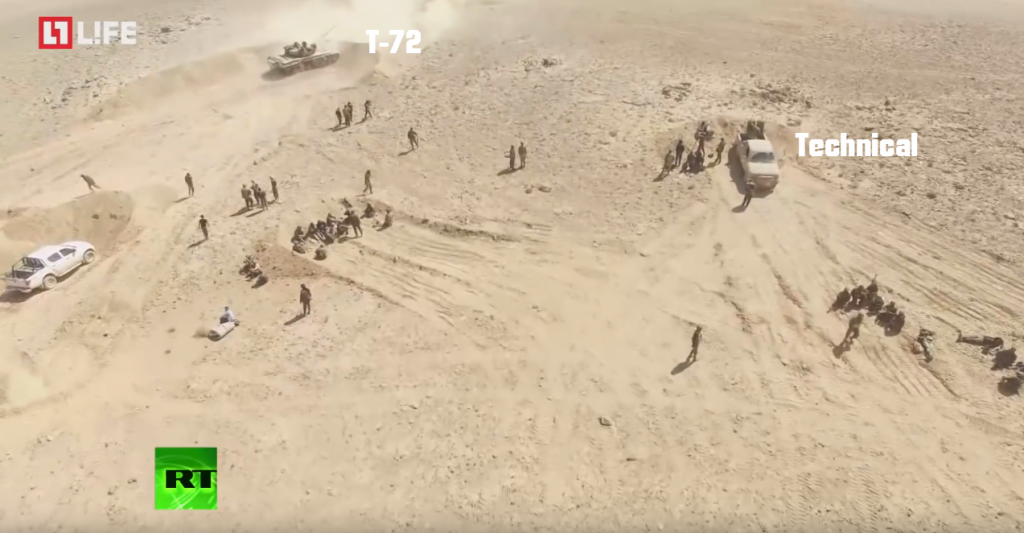
A staging area for an assault in the Syrian Desert, near Damascus, seen from a LIFE TV drone in the picture above. Approximately 2000 meters from the T-72 tank’s facing, a small settlement stands infested with ISIS. To some degree, the SAA has supplemented natural cover with prepared positions; mounds of dirt hastily created at the hands of a brave operator within an armored bulldozer. These positions represent more than a staging area for the assault, but the first position in a string of successive leaps where two or more SAA assault elements make successive advances on an isolated settlement.
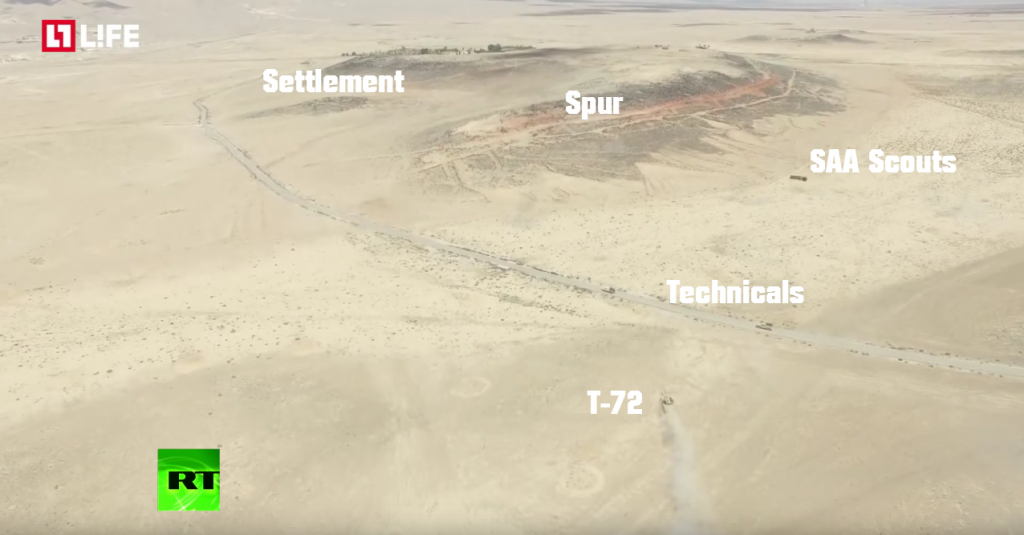
Where cover can’t be found, speed must be maintained. In this example, a T-72 and pair of technicals sprint across open ground towards a craggy spur. Not far beyond, the settlement and final objective. To the immediate front of the spur, a small roadside barrier hosts a few SAA scouts coordinating with the assaulting forces. The two technicals on the road are filled with troops ready to secure a position atop the spur.
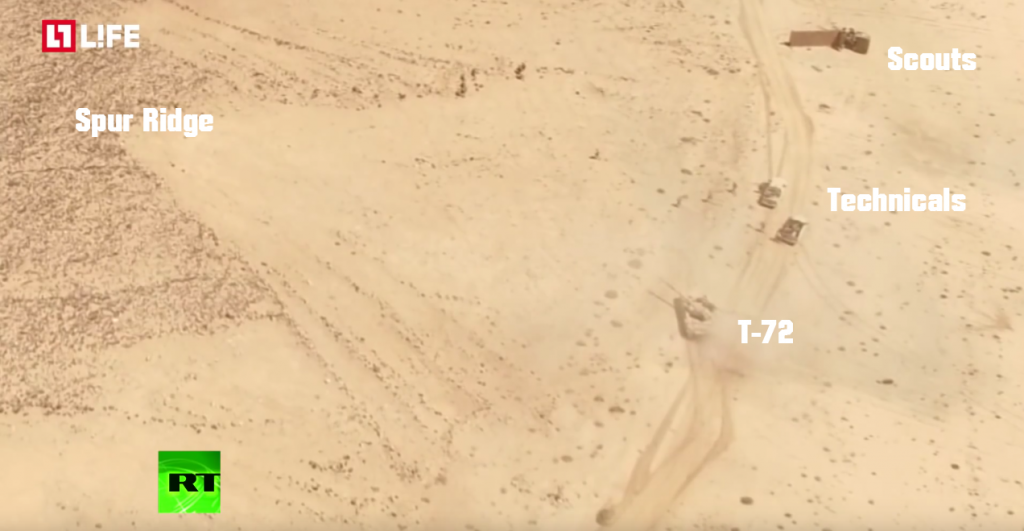
The roadside barrier and scouts can be seen in the upper portion of the image above. The two technicals are disembarking troops for the spur’s ridge. The T-72 provides overwatch for the assaulting troops.
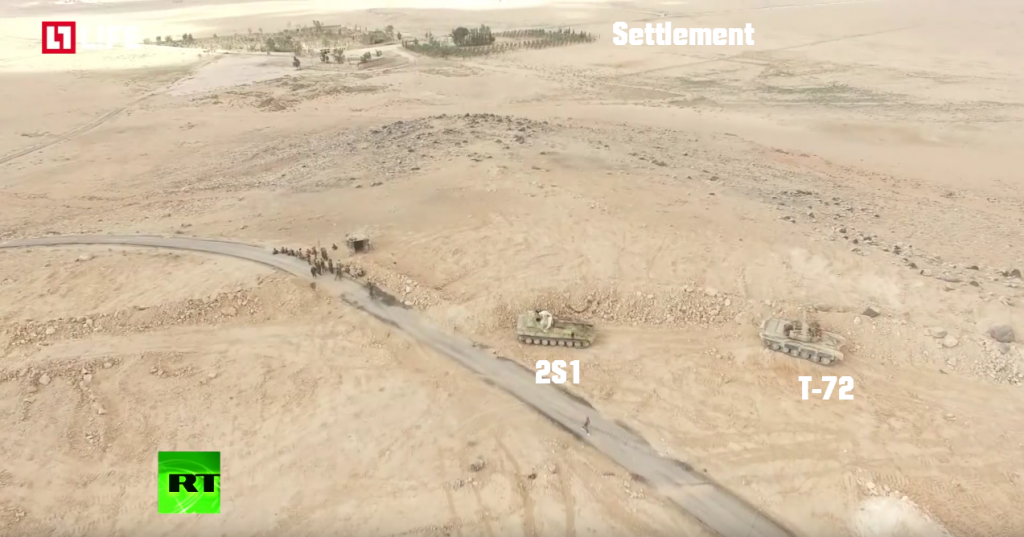
The troops take the ridge atop the spur and gain a commanding view of the settlement. Once the position is secure, a single 2S1 Gvozdika self-propelled howitzer joins the T-72 to lay down a barrage of high explosive (HE) on the settlement. It is important to note that the settlement is devoid of all life forms save for jihadists. ISIS executed all 280 civilians inhabiting the settlement, creating one of many ‘ghost towns’ dotting the Syrian Desert.
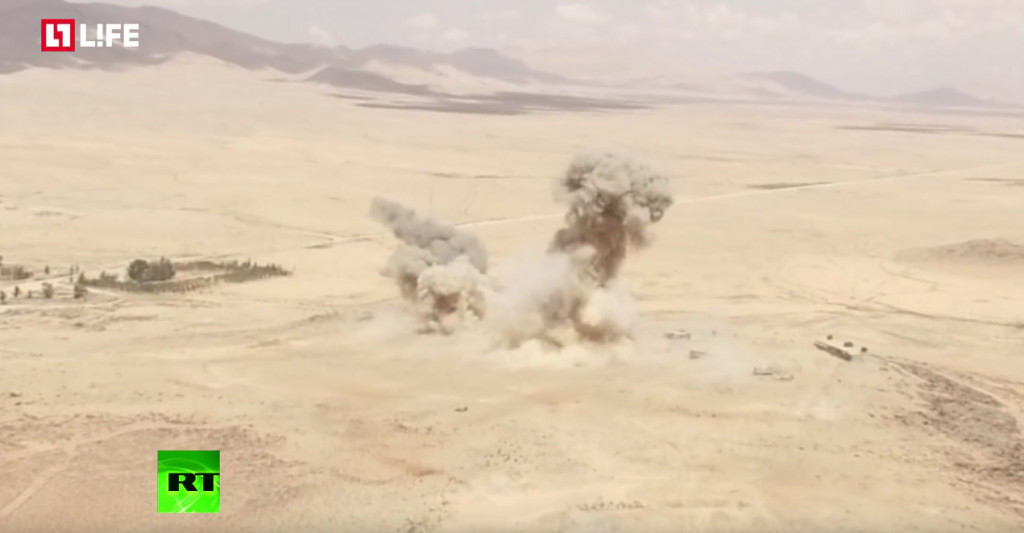
The T-72 and 2S1 deliver accurate fire against ISIS positions outside the settlement. In short order, all jihadist forces withdraw to the relative safety of the settlement buildings. With this action, the second phase of the settlement assault begins with infantry following the preceding artillery barrage.
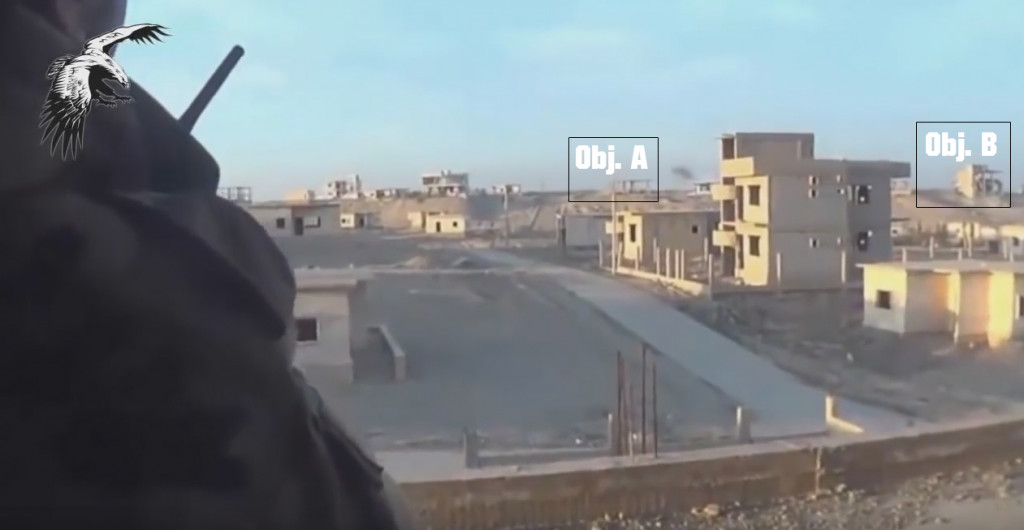
Unfortunately, there is no further footage of the final assault on the settlement itself from the previous example. However, there is SAA footage of a final assault on a similar settlement outside of Deir ez-Zor that has already been staged by the government forces. In the following case, we see SAA forces make their final assault on ISIS positions inside another ‘ghost’ settlement. In the image above, just over the commander’s silhouetted shoulder, Objective A houses jihadists armed with assault rifles and grenades. Objective B is further off to the right, and appears to have prepared positions dug on either side of the building.
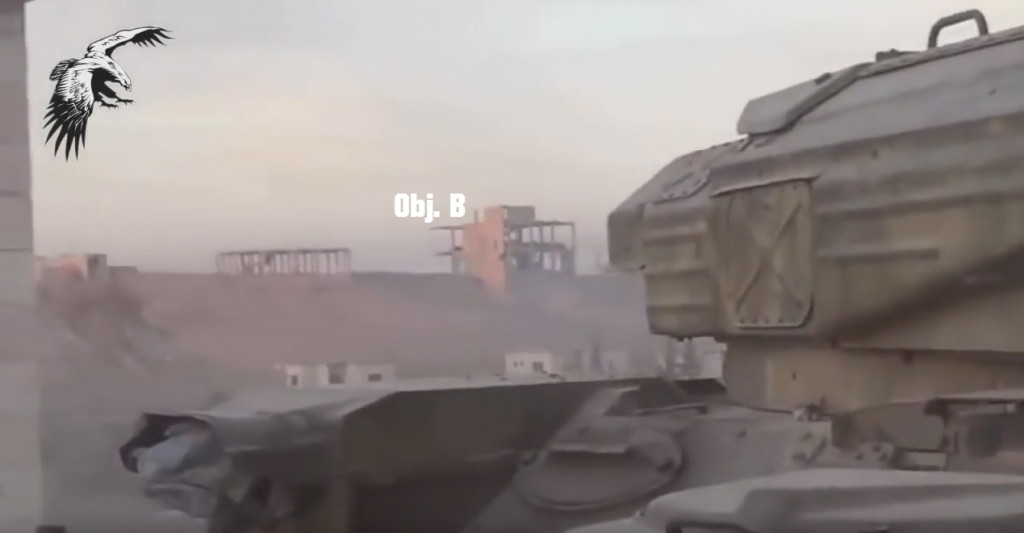
Where artillery isn’t available, the SAA is forced to improvise. Instead of suppressing the ISIS criminals with artillery fire, the SAA rake their positions with a ZSU-23-4 Shilka. The quadruple 23mm anti-aircraft guns fire snarling bursts of explosive shells, shredding the Objective B building where ISIS fighters hide.
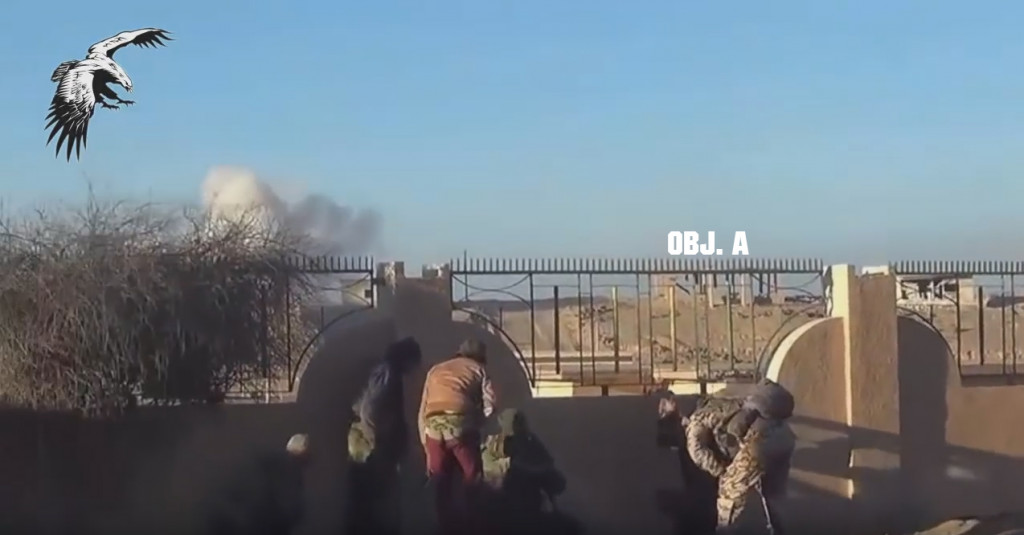
SAA troops get in position to assault Objective A, which is visible just beyond the fence on the hill. A cloud of dust from a 125mm HE round can be seen in the left portion of the screen grab.
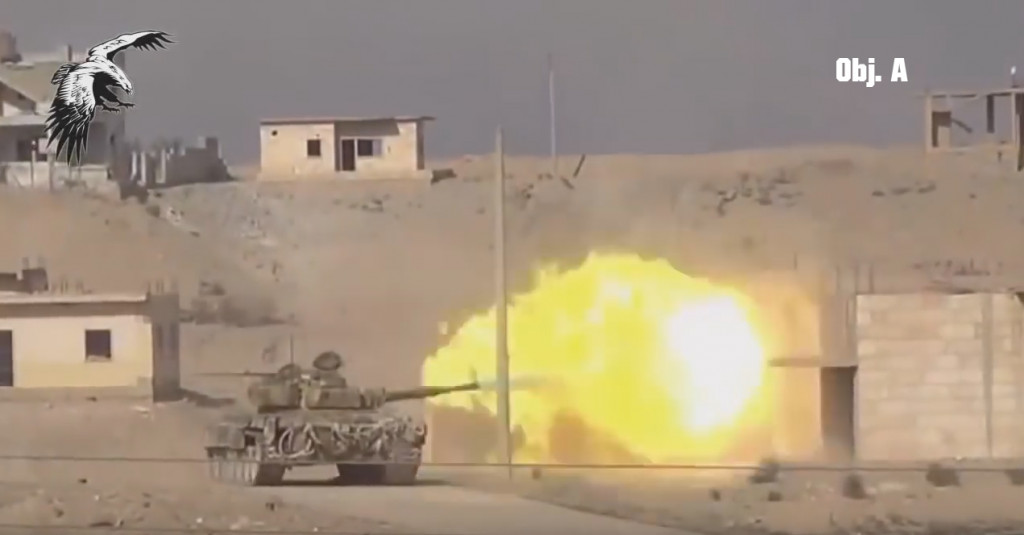
With Objective A in the background, a T-72 in the foreground belches fire as it delivers HE rounds to Objective B. After completing its rounds, the T-72 withdraws and the infantry begin their assault against a wounded and dazed enemy.
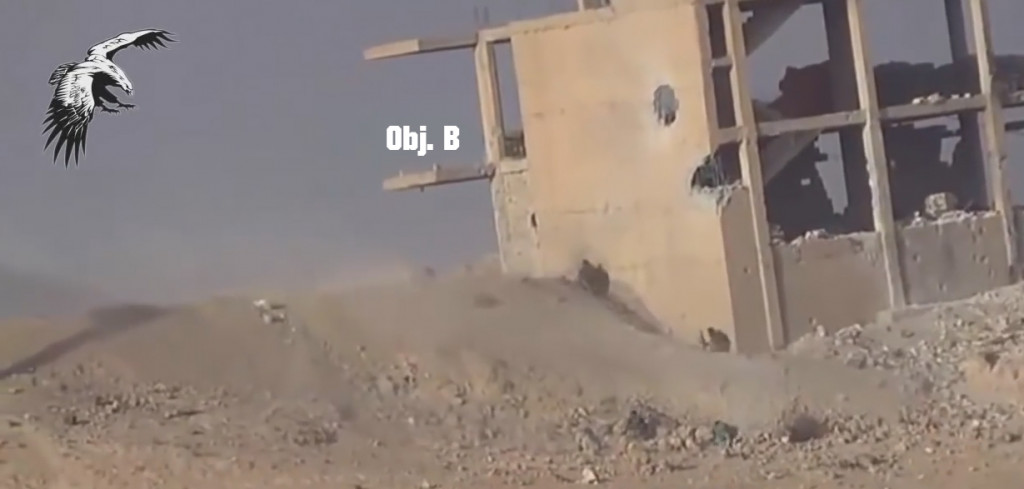
Objective B is seen pulverized by 125 mm HE and 23 mm Shilka rounds. SAA soldiers hug the walls of the building as they hurl grenades into the ISIS trenches. When a break in enemy fire is heard, the soldiers take turns firing over the threshold of the trench.
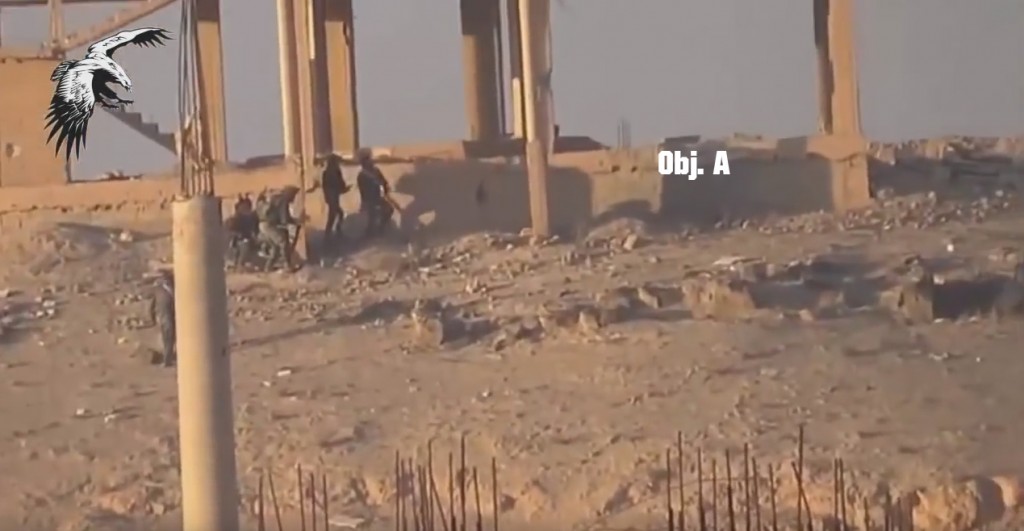
Syrian troops at Objective A provide flanking fire against ISIS positions, supporting their comrades at Objective B. Soon after, troops are seen standing triumphant on the hill waving the Syrian flag in a howling wind.
Qualitative Gains
Although the Syrian army has suffered quantitative losses in the defense of their country, officers in the rank-and-file describe a qualitative increase in their remaining strength. While equipment can be repaired and replaced, loyalty in the frontline fighters of the SAA cannot. Russian assistance in terms of T-72B and T-90S tanks, as well as air strikes have helped bolster SAA efforts in the conflict zone. However, in terms of manpower, the Syrian government continues to rely on a much smaller force of battle-hardened and loyal fighters. The SAA infantry man that remains in 2016 is an entirely different breed than his counterpart in 2011, at the outbreak of war. The tactics described above depict a fighting force that is no stranger to close contact, and capable of employing mobile, guerrilla-style tactics against criminal gangs.
Sources
- http://www.dw.com/en/the-many-fronts-in-syrias-civil-war/a-16868658
- https://warisboring.com/how-to-take-out-1-800-tanks-in-two-years-74ecd413cb93#.w6dogmxci
- http://carnegie-mec.org/2016/03/10/strength-in-weakness-syrian-army-s-accidental-resilience/iuz7
- http://www.dailystar.com.lb/News/Middle-East/2014/Oct-22/274895-syria-army-adapts-to-guerrilla-war.ashx#axzz3GNapFJpb
- https://www.youtube.com/watch?v=LDT0vAqbaKA
- https://www.youtube.com/watch?v=1q4sw5wkf90



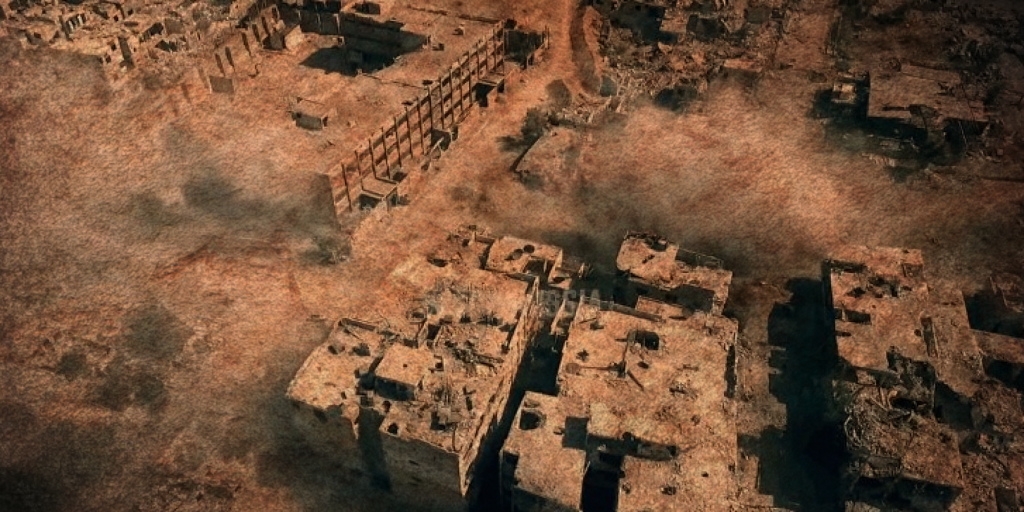



SAA and alawites are doomed….
Your doomed, you inbred wahhabi prick!
Your doomed because your patron is israel and america!
You are hated by billions of people!
We will hunt you down, Mr Testicle!
Oh yes defeated the 11 year old kid severed its head,you sick fks!
Shut the fuck up, foo!
What a wasteland… SAA needs dozens of UAVs and UCAVs for surveillance and to hunt down ISIS. UCAVs can be deployed over large area, either preparing infantry attack or just killing members of ISIS in free hunt. What is very important is UCAVs capability to strike terrorists without warnings in very clandestine manner. They should combat just like Azerbaijan did recently.
1 Turk Baryaktar drone 5 million , 1 Israeli Harop drone 10 million.
Azerbaijan have invested billions in drones and loitering (kamikaze) drones and drone ammunition.
Syria doesn’t have that kind of money not even close
Maybe flying Kamikaze Syrian soldiers riding tamed Desert Eagles?
Arab “Lord of the Rings” ?
quite frankly, if those are the actual prices, they are waaaaay overpriced for the technology. The Jewish price does not surprise me, but US/Darpa research aims to create these kinds of drones in the low thousand dollar range, and i think it’s doable. This is because the only advanced technology is really the software involved in drone flight, deconfliction with other drones, target recognition, and command and control. Otherwise, they are hobby planes/copters with bombs, so they WILL be cheap to produce.
Agree.
3D printing + mass produced commercial electronics – nothing fancy custom made.
No need for that, in majority of the drones. Specially smaller one.
Well whatever the tactics are they are not working as good as they should,if those rats are in so called desert settlements that means they can be spotted from drones and aircraft,the SAA should have deployed small heavily armed mobile units of special forces to hit those settlements in the early hours of the morning,those are the tactics the British long range desert group and the SAS used against the Africa Korps in WW2,and it was devastating,another option would be for airborne forces to be inserted using helicopters backed up by Russian Combat choppers,the only other way to take full control would be for Iran to send thousands off troops complete tank divisions,they have the manpower.
Iran, Russia to Maintain Military Cooperation in Spite of US Sanctions, Iranian Ambassador Confirms
“This behavior of the United States will continue in the future, and the reason is that the US no longer enjoys the dominance of the past. It wants to say that it is the world’s number-one power, while that is not the case as there are several countries that have caught up and overtaken it,”…………….
……………..”Russia, China, Iran and other countries subjected to sanctions should stand together and show that the forceful use of instruments of power on the international scene is an illegal act that may lead to harmful consequences for countries and peoples,” Jalali added.
https://sputniknews.com/middleeast/202012181081501250-iran-russia-to-maintain-military-cooperation-in-spite-of-us-sanctions-iranian-ambassador-confirms/
The solution for Al Tanf would be to build trenches and settlement around it: to prevent ISIS to get supplies from CIA and USA.
At that point a big operation to clear the area would wipe ISIS almost completely.
But to do that, they would first need to recapture or secure Idlib: so they would have more personal and equipment available.
I know it easier said than done, but it’s the only solution.
It is very difficult because just a pick up truck can travel at 120km through desert with 4 ISIS members and launch fast and run atttack or plant mine.. while SAA inside outpost think that incoming vehicle can be SAA or NDF…( they surey use Syrian flag to confuse)…very difficult to avoid it…unless they use Otto Skorzeny tactic..which is to send SAA special forces deployed deep wit ISIS “clothes and flags”…to spot them…when ISIS ( with SAA suits) and SAA ( with ISIS suits)..be both close…surely ISIS will have doubts and will stop the ambush…among other reason SAA knows the exact position of his “false troops”..but I have doubts that ISIS have the control of all ISIS movements inside Homs desert…
Too many tv games for today!
Thats thought Americans troops in WW2 when US military told to Gen Omar Bradley that German soldiers wore US garments and spoke English…yes indeed a game that slowed down progress…
Friendly fire has entered the chat.
PRIVATE SPYING COMPANIES WHICH THE CIA BOUGHT UP USING IT’S ” In -Q-Tel FUND” based in the Blue state of California ;_
1.Geofeedia
2.PATHAR ” SOCIAL MEDIA INTELLIGENCE”
3.DATAMINR. WHICH THEN LATCHED UNTO TWITTER
4.KEYHOLE
ONCE OWNED BY JOHN HANKE., who named it’s company after a CIA project,
saw it bought up by the CIA IN 2003. KEYHOLE WAS MARRIED TO NATIONAL
GEOSPATIAL INTELLIGENCE. AGENCY. NGIA became an employer of 14,500
employees/spies with a $5 billion budget, whose job was deliver
information to the CIA. That spying project WAS THEN SOLD TO Google by
CIA for possibly billionS, whiCh is why the DEAL REMAINS SECRET EVEN TO
TO us elected CONGRE$$
GOOGLE IS ENABLING THE US ARMY TO SPY ON SAA AND OTHER SOLDIERS. SINCE 2003
Last year the Russians used a thermobaric bomb to wipe out 200 terrorists in one hit, they were fleeing Aleppo and were strung out in a column 150 meters long, there wasn’t much incendiary damage and most of the equipment remained undamaged, but one bomb wiped out 200 men.
This town would’ve been a good target for a thermobaric bomb, and at a cost of just a couple of hundred thousand US dollars, and the cost of running the bombing crew and plane, I’d say it would be good value, kill most of the terrorists, leave most of the infrastructure intact, and just let the SAA go in and mop up the dazed and confused survivors.
I don’t like these tactics and much prefer the US’s, send in the airforce to do all the heavy lifting, and then send the troops in to mop up what’s left, don’t risk SAA lives unnecessarily.
One tiny problem: with video “The SAA advances on ISIS near Damascus”
Um.. There shouldn’t be any ISIS by now in Syria.